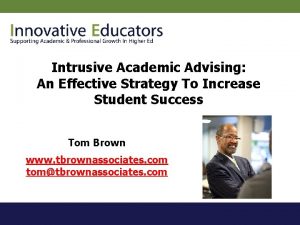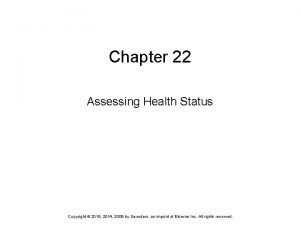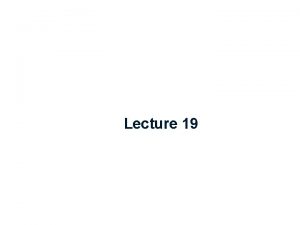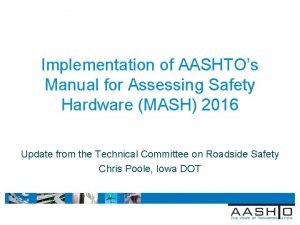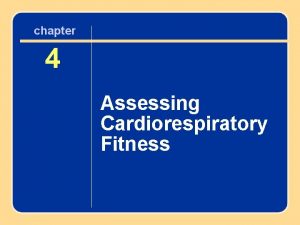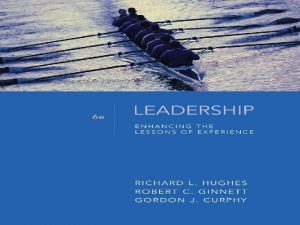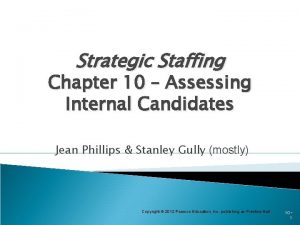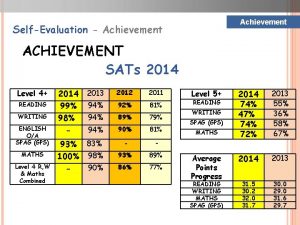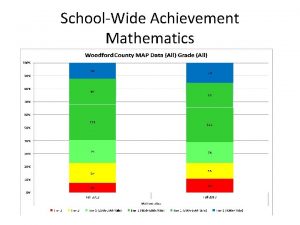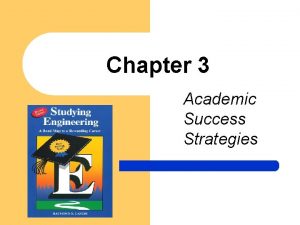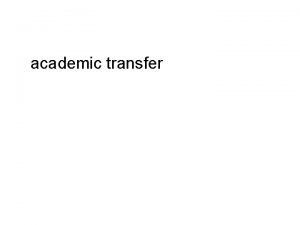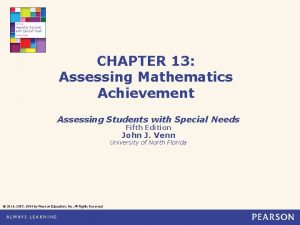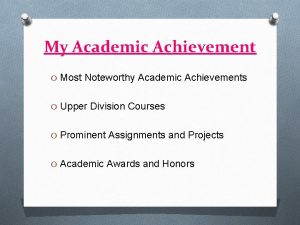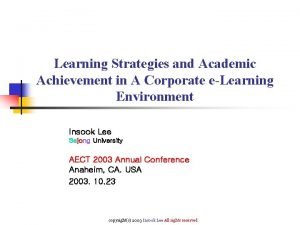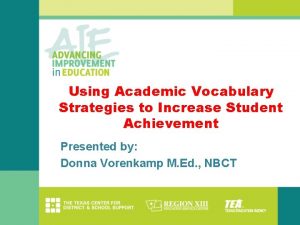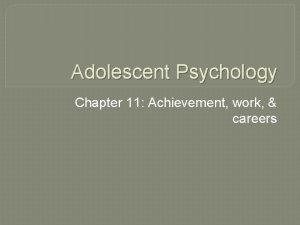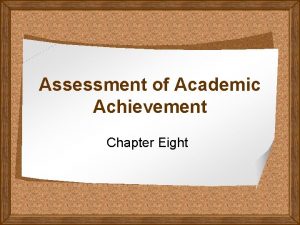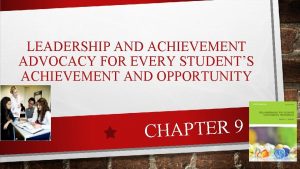CHAPTER 11 Assessing Academic Achievement General Strategies Assessing

















- Slides: 17

CHAPTER 11: Assessing Academic Achievement: General Strategies Assessing Students with Special Needs Fifth Edition John J. Venn University of North Florida © 2014, 2007, 2004 by Pearson Education, Inc. All Rights Reserved

Overview • • • Definition Curriculum-Based Strategies – Curriculum-Based Assessment (CBA) – Classroom Assessment Techniques (CATs) – Curriculum-Based Measurement (CBM) Norm-Referenced Tests Venn. Assessing Students with Special Needs, 5 e. © 2014, 2007, 2004 by Pearson Education, Inc. All Rights Reserved 11 -2

Overview • Measuring academic learning is a central aspect of teaching students with learning problems. • Teachers use a diverse array of tools, techniques, and strategies to assess student achievement. • Widely used assessments include informal, curriculum-based strategies and formal, standardized tests. Venn. Assessing Students with Special Needs, 5 e. © 2014, 2007, 2004 by Pearson Education, Inc. All Rights Reserved 11 -3

Definition • Academic achievement is student performance after instruction • Includes reading, mathematics, and written expression • Academic areas subdivide into specific skills – Reading includes word identification, word attack, comprehension, and oral reading skills Venn. Assessing Students with Special Needs, 5 e. © 2014, 2007, 2004 by Pearson Education, Inc. All Rights Reserved 11 -4

Definition Why Do We Assess Achievement? • To screen students who may have deficits • To identify students with disabilities • To determine present levels of academic performance • To develop IEPs • To plan instructional programs and develop intervention activities • To evaluate student progress • To monitor program effectiveness Venn. Assessing Students with Special Needs, 5 e. © 2014, 2007, 2004 by Pearson Education, Inc. All Rights Reserved 11 -5

Curriculum-Based Assessment (CBA) • A variety of approaches for measuring performance based on student progress in the curriculum • Also referred to as authentic assessment or performance assessment • Relies on teacher-made tests, checklists, rubrics, classwork, homework assignments, and teacher impressions Venn. Assessing Students with Special Needs, 5 e. © 2014, 2007, 2004 by Pearson Education, Inc. All Rights Reserved 11 -6

Curriculum-Based Assessment (CBA) • • Directly links assessment with instruction Examples – Tests, exams, quizzes – Portfolios – Games – Presentations – Rubrics Venn. Assessing Students with Special Needs, 5 e. © 2014, 2007, 2004 by Pearson Education, Inc. All Rights Reserved 11 -7

Classroom Assessment Techniques (CATS) • Helps determine what students think about a class and how well they are learning the material • Focus on the effectiveness of the curriculum rather than student performance • Examples – Chain notes – Exam evaluations – Minute papers – Student-generated test questions Venn. Assessing Students with Special Needs, 5 e. © 2014, 2007, 2004 by Pearson Education, Inc. All Rights Reserved 11 -8

Curriculum-Based Measurement (CBM) • • Repeatedly measures student progress in meeting instructional objectives Key characteristics – Quick and easy to give; accurate – Brief probes (tests) given often (e. g. weekly) – Uses standardized probes with benchmarks – Graphing of data to show progress over time and to help make instructional decisions Venn. Assessing Students with Special Needs, 5 e. © 2014, 2007, 2004 by Pearson Education, Inc. All Rights Reserved 11 -9

Curriculum-Based Measurement (CBM) Progress Monitoring Steps (1 -3) 1. School-wide screening (3 times a year) 2. Identifying at-risk students who need progress monitoring 3. Ongoing progress monitoring for at-risk students Venn. Assessing Students with Special Needs, 5 e. © 2014, 2007, 2004 by Pearson Education, Inc. All Rights Reserved 11 -10

Curriculum-Based Measurement (CBM) Progress Monitoring Steps (4 -6) 4. Review data and make assessment decisions 5. Implement instructional changes 6. Continue to monitor progress Venn. Assessing Students with Special Needs, 5 e. © 2014, 2007, 2004 by Pearson Education, Inc. All Rights Reserved 11 -11

Sample Progress Monitoring Graph Venn. Assessing Students with Special Needs, 5 e. © 2014, 2007, 2004 by Pearson Education, Inc. All Rights Reserved 11 -12

Norm-Referenced Tests • Hundreds of available tests including – Group screening tests and individual diagnostic tests – Multiple skill (e. g. reading, math, and writing) and single skill (e. g. reading only) tests • Common characteristics – Fixed set of test items – Standardized administration and scoring protocols – Norms developed from representative groups of students Venn. Assessing Students with Special Needs, 5 e. © 2014, 2007, 2004 by Pearson Education, Inc. All Rights Reserved 11 -13

Norm-Referenced Tests Group tests • Brief screening tests for groups of students • Results provide an overview of achievement • Usually machine scored, multiple-choice tests • May be difficult for students from diverse backgrounds and students with disabilities Venn. Assessing Students with Special Needs, 5 e. © 2014, 2007, 2004 by Pearson Education, Inc. All Rights Reserved 11 -14

Norm-Referenced Tests Individually-Administered, Multiple-Skill Tests • Frequently used by teachers, diagnosticians, and psychologists with students from kindergarten through high school • Widely used tests include the – Peabody Individual Achievement Test— Revised/Normative Update (PIAT-R/NU) – Kaufman Test of Educational Achievement, Second Edition (KTEA-II) – Wechsler Individual Achievement Test, Third Edition (WIAT-II) Venn. Assessing Students with Special Needs, 5 e. © 2014, 2007, 2004 by Pearson Education, Inc. All Rights Reserved 11 -15

Norm-Referenced Tests • PIAT-R/NU – Measures general information, reading recognition, reading comprehension, mathematics, spelling, and written expression • KTEA-II – Measures reading decoding, reading comprehension, spelling, mathematics computation, and mathematics applications • WIAT-III – Measures oral language, reading, written expression, and mathematics Venn. Assessing Students with Special Needs, 5 e. © 2014, 2007, 2004 by Pearson Education, Inc. All Rights Reserved 11 -16

Summary • One of the most important and diverse elements of assessing students with special needs • Includes – Assessment of students from kindergarten through adulthood – Three major strands: reading, math, written language – Large assortment of available assessment procedures and tests ○ Informal, curriculum-based and formal, norm-referenced • Students with disabilities – Often have difficulties learning academics – Require a variety of measures to meet individual and unique learning needs Venn. Assessing Students with Special Needs, 5 e. © 2014, 2007, 2004 by Pearson Education, Inc. All Rights Reserved 11 -17
 Effective academic advising strategies
Effective academic advising strategies Chapter 4 cultural dynamics in assessing global markets
Chapter 4 cultural dynamics in assessing global markets Assessing health status chapter 22
Assessing health status chapter 22 Planos en cinematografia
Planos en cinematografia Where did general lee surrender to general grant?
Where did general lee surrender to general grant? Unit 3 assessing risk in sport
Unit 3 assessing risk in sport Unit 18 assessing children's development support needs
Unit 18 assessing children's development support needs Assessing grammar effectively
Assessing grammar effectively Philippine professional standards for teachers domains
Philippine professional standards for teachers domains Task analysis in hrd
Task analysis in hrd Informal reading assessment
Informal reading assessment Manual for assessing safety hardware
Manual for assessing safety hardware Assessing a new venture's financial strength and viability
Assessing a new venture's financial strength and viability Assessing cardiorespiratory fitness
Assessing cardiorespiratory fitness Assessing leadership and measuring its effects
Assessing leadership and measuring its effects Many new drivers first fender bender is a backing collision
Many new drivers first fender bender is a backing collision Module 4 topic 1 assessing and managing risk
Module 4 topic 1 assessing and managing risk A nine box matrix requires assessing employees on ________.
A nine box matrix requires assessing employees on ________.
